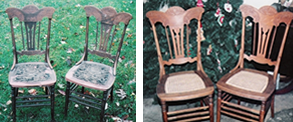There are many approaches to restoration. At TaleWeavers, we are firm believers in preserving the integrity and history of each piece of furniture with which we work.
In seat weaving, we strive to secure materials that will enable us to match the pattern in the seat area. When reweaving a seat, we document the original seat materials and design, then select materials that match the materials available today to the materials of the past. The patterns for seatweaving are many, but we a well versed in matching and reweaving any pattern.
We take a conservative approach that permits us to repair or replace visible parts to create an authentic look. Structural framework or others parts that are not visible may be replaced or enhanced so that the furniture piece is functional.
In seat weaving, we strive to secure materials that will enable us to match the pattern in the seat area. When reweaving a seat, we document the original seat materials and design, then select materials that match the materials available today to the materials of the past. The patterns for seatweaving are many, but we a well versed in matching and reweaving any pattern.
We take a conservative approach that permits us to repair or replace visible parts to create an authentic look. Structural framework or others parts that are not visible may be replaced or enhanced so that the furniture piece is functional.
Protecting Your Investment
Hand Caning or Prewoven Caning
Binder Cane
Fiber Rush
Natural Rush
Flat Reed
Oak Splint
Hickory Splint
Shaker Cloth Tape
Hand Caning or Prewoven Caning
- Caning is a natural bark material. It requires little maintenance and will last 20-25 years. Spray a light mist of water on the underside of the seat every 6 months. The moisture will keep the caning from becoming brittle. Keep the pieces out of direct sunlight and away from the vents of forced air home heating and cooling systems, wood/coal stoves and heaters, fireplaces, and radiator heating units.
Binder Cane
- Binder is a natural bark material. It is wider than the caning material used in hand caned and prewoven cane seats, so it will last a long time when maintained properly. Spray a mist of water on the top and bottom sides of the binder cane. Because it is thicker than the regular cane strands, spray liberally, allowing the mist to reach the underside of the binder cane strands. Keep the pieces out of direct sunlight and away from the vents of forced air home heating and cooling systems, wood/coal stoves and heaters, fireplaces, and radiator heating units.
Fiber Rush
- Fiber rush of ages past were woven from cattails (or the English BulRush). Today, rush seats are usually woven with twisted kraft paper or hand twisted seagrass. The common treatment for the paper rush seats is the application of a mixture of denatured alcohol with clear shellac (3:1 ratio).
Natural Rush
- Natural rush is made from seagrass harvested along the shorelines of southeast Asia. The long strands of grass are hand twisted, creating a long cord used to weave rush seats. The natural rush varies in width, but it has the appearance of the original bulrush or cattail rush. Care of natural rush includes dry brushing with a soft bristle hand brush and light water spray to keep the material from drying out too much. A mixture of denatured alcohol with clear shellac can help to protect the rush material from food stains.
Flat Reed
- Flat reed is basket material, the inner material from the Rattan vine. It is an alternative seat weaving material to the split oak or hickory used in the past. It is pliable when wet and is readily available today. The reed can be stained and treated with a light coating of clear shellac. Over time the flat reed will dry out, so an light water spray every 6 months will help to maintain the reeds moisture content and elasticity.
Oak Splint
- Oak splint were used in the 19th and early 20th century in the weaving of seats. Oak is one of the only North American trees that can be hand split into weaving strands. Over time, the oak will dry out. To maintain flexibility in the splints the seats should be sprayed with water, allowing the weavers to absorb the moisture. Oak can be stained, but should not be treated with a finish, as this will prevent the splints from absorbing moisture and they will become brittle. Brittle seats will break and will need to be replaced with new oak splints or flat reed.
Hickory Splint
- Hickory splints were cut by by hand and commonly used to weave seats in chairs and rockers made of hickory frames. As with any natural material, hickory can dry out and become brittle. To maintain the moisture content of a woven hickory seat, spray the seat with water about every 6 months. Hickory is typically not stained or treated with a finish. New weavings will darken over time, creating their own color and patina.
Shaker Cloth Tape
- Shaker Tape seats are woven using cloth tape, woven in narrow bands, normally 5/8 or 1 inch wide. The tape comes of rolls and can be woven using a number of patterns, just like flat reed, binder cane, or any of the splint material. In many cases, two colors are used to accent the pattern being woven. Shaker tape should be brushed lightly with a soft bristle brush for cleaning. Do not use liquids, stains, or finishes on the tape. Normally, there is a foam core that is placed inside the weaving of the seat. The foam can break down and leave dustings under the chair. The foam can only be replaced by unweaving or reweaving the seat.

